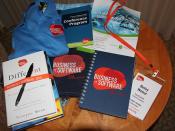Abstract
The focus on any exporting business is the ability to differentiate the type of market one is venturing into, such as domestic or international, their governing laws and regulations, market specific knowledge, financial risks and control of trade information. The analysis of marketing competencies between exporting and non-exporting firms and the different stages of their internationalization process, namely product adaptation and managing relationship with distributors.
Table of contents
Abstract 2
Table of contents 3
Introduction 4
Factors influencing a firm's export performance 4
China and U.S. trade 7
Conclusion 10
References 10
Introduction
This paper aims to look at the various factors that may influence export performance. For example, management characteristics such as motivation to export, perceptions and personal characteristics; firm characteristics such as size, competencies, marketing mix strategy, marketing policy and planning, relationship strategy; as well as country characteristics such as whether it is a developed or undeveloped country.
The competitive advantage in price, technology, product uniqueness, market knowledge, managerial skills and financial resources were found to significantly differentiate exporting from non-exporting firms (Jatusripitak 1986; Rous 1987). Owing to the nature of the export channel environment, exporting firms cannot rely solely on their internal competencies for achieving competitive advantages and export success. Instead, exporters must look beyond the firm's boundary to tap into the distinctive competencies of external actors such as distributors if they want to realize the full potential of their products.
Factors influencing a firm's export performance
A firm's export involvement can be attributed to a complex interaction of internal and external factors & a firm's export behaviour in terms of motives as illustrated by the table from Albaum et al. 2002, p. 48.
Proactive | Internal | External |
Managerial urge | Foreign market opportunity | |
Marketing advantage | Change agents | |
Economies of scale | ||
Unique product/technology competence | ||
Reactive | Risks diversification | Unsolicited order |
Extend sales of a seasonal product | Small home market | |
Excess capacity for resources | Stagnating or declining home market |
Businesses need to understand and deal with regulations put in place by governments which might encourage and discourage certain economic activities. It is therefore essential that we understand the rationale of government policies with respect to exporting and importing activities within the economy because more often than not, governments display a neomercantilist attitude by promoting exports and restricting imports. It is importance to view the trading activities of a nation by looking at a country's balance of payments which records the flows of money between residents of that country and the rest of the world in terms of products and services, whether it has a trade surplus or deficits. If it's the latter, it would mean the country is losing its wealth because it is always buying more than it is selling. The restrictions of imports through various measures including tariffs, import quotas, voluntary restraint agreements (VRAs), non-tariff trade barriers, antidumping and countervailing duties will thus be introduced to control and protect the internal/domestic market. This will have an impact on the types of goods & services exporting out from the firms into these countries. The government export promotion measures in the form of subsidy, tax incentives, information advice and financial support in the exporting countries will have a direct impact on the firms exporting performance to encourage more involvement in international trading activities.
Next we need to understand the theories which concern the question 'why nations trade' which are classified under three headings (Albaum et al. 2002, pp. 40-3):
The classical theory of international trade
The factor proportion theory
The product lifecycle theory of international trade
Firms export to satisfy emerging demand in a foreign market and make substantial profits when a commodity is in short supply in that market. It provides opportunity for growth when the local market is stagnant and allowing firms to exploit economics of scale to its fullest by increasing production thus lowering the unit cost. It'll yield better returns on a firm's investment in the foreign market providing better prices with government support as mentioned earlier. Products will extend it's lifecycle by exporting them to third world/undeveloped countries, for examples like used cars of less than 10 years in Singapore are re-export to Indonesia, Sri Lanka, Africa, Cambodia, Vietnam, etc.
The diamond chart by Porter, M., (1998b, The Competitive Advantage of Nations, p. 72) focus the new theory of international trade as to why certain nations excel in trade by looking at the four broad attributes of comparative advantage to foster innovation within a certain economy:
Factor conditions. Costs of skilled labour or infrastructure (production plant, raw materials) necessary to compete in the given industry
Demand conditions. The demand of the industry's products or services
Related and supporting industries. The presence or absence of supplier industries and related industries that are internationally competitive
Firm strategy, structure and rivalry. The governing policies in the nation that determines how companies are created, organized and managed, and the nature of domestic rivalry. (Porter, 1998b, p. 71)
The other famous economists Adam Smith in essence said that: because some countries can produce certain goods more efficiently than other countries, they should specialize in and export these products and other countries can export those products in which they have more efficiency. It would be beneficial for a country to produce something when they have absolute advantage, say for example like DELL which could produce & deliver more computers than their competitors anywhere in the world, thus reaching economic of scale. They should capitalize on this to further expand their business internationally.
To compete globally, you have to be big, with strong capital capable of bearing large investment and high risks associated with exporting. Firms will also need strong human capital with skills and technological capabilities to venture out into new market as over dependence of traditional export markets will not bring profits and perhaps risk being overrun by their competitors with more innovative products & services. Innovation is an important determinant of competitiveness. The importance of having innovative products & services coupled with strong pricing strategy to enter new export markets are crucial. The challenge of managing a marketing function is greater when a firm decided to extend its business horizon beyond national boundaries, and the lack of marketing skills to market overseas and advertise in foreign markets has often been cited as one of the major determinants of export performance.
Aaby and Slater (1989) suggest that marketing performance is directly influenced by a firm's business strategy. Using factor analysis, Cavusgil (1983) demonstrated that marketing decision variables influencing successful export marketing performance can be reduced to (1) basic company offering, (2) contractual link with foreign distributors/agents, (3) promotion, and (4) pricing. Firms need to look at strategizing the 4Ps of marketing mix, namely Product, Price, Promotion and Place into the respective country and/or market, and understands what are the controllable & uncontrollable variables. As international trade of goods (and services) requires efficient, time-specific and competitive means of moving goods (or people), it relies heavily on logistics services such as transportation (modes), packaging (types), warehousing (equipments), physical distribution management (thru agent/distributors), documentation management, inspection services, etc. The need of an effective logistics to work out the optimize freight to ship out the right product, with the right price and arrive in the market at the right time are factors affecting the export performance. The ability to bring products closer to the market in the shortest possible time will have a competitive edge over other suppliers in terms of pricing, thus able to fetch a premium depending on the demands. One important service provided by leading logistics service providers is the strategic management of information, which is very crucial in the context of modern requirements of international trade.
International trade will not be possible without financial support by banks for exporters and importers both at the pre-transaction and post-transaction stages. Considering the complex nature of international transactions, without financial services such as credit facilities like Letter of Credit to manage the risks of non-payment issues, and the fact that it's becoming so widely available at relatively low costs, international trade will not be so vibrant as it is today. The other important aspect will be the documentation flow which determines how fast the documents such as invoice, packing list, bills of lading, certificate of origin, certificate of insurance, etc are issued and send across to banks & buyers for negotiation of payment & clearance of their goods. Firms will need to look at better management of their cash flow by setting specific payment terms like T/T in advance, T/T 30 days after B/L date, etc if they're not big enough to manage the risks & capital intensive of large scale export requirements.
China and U.S. trade
One of the most preferred exporting countries will be China due to their cheap labour and infrastructure costs, availability of raw materials such as coal, iron, ore, etc. During the last century, we saw a tremendous growth of foreign investments in China, with businesses setting up their offices in major part of China, especially Shanghai & Beijing and production plant in Ningbo, Guangzhou, etc. As cheap labour is the foundation of the Chinese economy, it enabled businesses to produce products massively without the needs of expensive equipments such as toys, and providing extra services needed in the tourism/entertainment industry, customer relationship management (CRM) & the logistics arena. According to the International Herald Tribune, December 6, 2007, GM expects to invest $5 billion in China over the next five years to expand production facilities. Let's look at the table below on China-U.S. trade as the preferred option.
Preferred Exporting Country | Potential Markets |
China | United States |
Total U.S.-China trade, which totalled only $5 billion inn 1980, rose to $387 billion in 2007. The U.S. trade deficit with China have grown much faster than U.S. export to China as seen in the table below extracted from U.S. International Trade Commission Trade Data Web (http://dataweb.usitc.gov/) .
U.S. Merchandise Trade with China: 1980-2007
($ in billions)
Year | U.S. Exports | U.S. Imports | U.S. Trade Balance |
1980 | 3.8 | 1.1 | 2.7 |
1985 | 3.9 | 3.9 | 0 |
1990 | 4.8 | 15.2 | -10.4 |
1995 | 11.7 | 45.6 | -33.8 |
2000 | 16.3 | 100.1 | -83.8 |
2001 | 19.2 | 102.3 | -83.1 |
2002 | 22.1 | 125.2 | -103.1 |
2003 | 28.4 | 152.4 | -124.0 |
2004 | 34.7 | 196.7 | -162.0 |
2005 | 41.8 | 243.5 | -201.6 |
2006 | 55.2 | 287.8 | -232.5 |
2007 | 65.2 | 321.5 | -256.3 |
It's been noted by trade analysts that China continues to pursue industrial policies aimed at promoting the development of industries that have been deemed by the government as critical for Chinese future economic development, with policies seek to restrict imports of finished products, thus forcing foreign firms to invest in China to gain access to the domestic market. A significant level of U.S. export to China are raw materials, parts and components used to produce finished goods for export. This is deemed as one of the comparative advantage to encourage trading & making efficient use of each other competency in their areas of expertise.
The top five U.S. imports from China in 2007 were computers and parts, miscellaneous manufactured articles (such as toys, games, etc), communications equipment, apparel, and audio and video equipment as illustrated by the table below from U.S. International Trade Commission Trade Data Web (http://dataweb.usitc.gov/).
Top Five U.S. Imports from China: 2003-2007
($ in billions and % change)
NAIC Commodity | 2003 | 2004 | 2005 | 2006 | 2007 | 2006-2007 % change |
Total All Commodities | 152.4 | 196.7 | 243.5 | 287.8 | 321.5 | 11.7% |
Computer equipment | 18.7 | 29.5 | 35.5 | 40.0 | 45.5 | 11.0 |
Miscellaneous manufactured products (e.g., toys, games, etc.) | 21.8 | 23.7 | 26.4 | 28.9 | 34.8 | 20.6 |
Communications equipment | 5.9 | 9.0 | 14.1 | 18.0 | 23.2 | 29.0 |
Apparel | 9.0 | 10.5 | 16.4 | 19.2 | 23.0 | 19.4 |
Audio and video equipment | 10.0 | 12.6 | 15.6 | 18.8 | 19.1 | 1.5 |
Note: Commodities sorted by top five imports in 2007 using NAIC classification, four-digit level.
The sharp increase in U.S. imports from China is largely the result of movement in production facilities from other (primarily) Asian countries to China. That is, various products that used to be made in Japan, Taiwan, Hong Kong, etc., and then exported to the United States are now being made in China and exported to the United States, reasons being of the low production cost in terms of labour, land, close proximity to other suppliers of raw materials within the zone, etc. Chinese data indicate that the share of China's exports produced by foreign-invested enterprises (FIEs) in China rose from 1.9% in 1986 to 57% in 2007.
Conclusion
There is little empirical evidence of the strategic impact of resources and capabilities that can be shared in marketing's cooperative relationships. This study raises two research questions: (1) does a firm's relational capability contribute to its export competitive advantages? and (2) does a firm's relational factors make an incremental contribution to its export advantage and performance beyond the contribution of firm factors. A significant conclusion of this study is that after controlling for internal firm factors, relational factors make a unique contribution to both the competitive advantages of the firm and its export performance.
References
Aaby, N. and Slater, S.F. 1989, 'Management influences on Export Performance: A Review of the Empirical Literature 1978-1988', International Marketing Review 6(4), pp. 7-26.
Akhter, Syed H. 1995, 'Global Marketing: Concepts, Strategies, Practise, Text and Readings'n, South Western College Publishing.
Albaum, G, Strandskov, J & Duerr, E. 2002, 'Extract from Chapter 4', International marketing and export management, 4th edn, Prentice Hall, Essex.
Axinn, C. 1988, 'Export Performance: Do Managerial Perceptions Make a Difference?', International Marketing Review 5, pp. 61-71.
Branch, A 2000, 'Extracts', Export practice and management, Thomson Learning, London, pp. 32-40, pp. 128-43.
Bijmolt, T. 1993, 'Factors Influencing Export Success: A Multi-level Analysis of Difference across Firms and Sectors', Research Memorandum from Institute of Economics, University of Groningen.
Bureau of East Asian and Pacific Affairs, 2008, Background Note: China. [Online].
Available at: http://www.state.gov/r/pa/ei/bgn/18902.htm [accessed 03 April 2008]
Cooper, S & Nyborg, I. 1998, 'The financing and information needs of the smaller exporters', Bank of England Quarterly Bulletin, May 1998, pp. 166-72.
Fletcher, R & Brown, L. 2002, 'Extract from Chapter 12', International marketing: An Asia-Pacific perspective, 2nd edn, Pearson Education, Frenchs Forest, NSW, pp. 378-92.
FTDWebMaster, Foreign Trade Division, U.S. Census Bureau, 2008, Trade in Goods (Imports, Exports and Trade Balance) with China. [Online]. Washington, D.C. 20233.
Available at: http://www.census.gov/foreign-trade/balance/c5700.html [accessed 10 April 2008].
Katsikeas, CS, Piercy, NF & loannidis, C. 1996, 'Determinants of export performance in a European context', European Journal of Marketing, vol. 30, no. 6.
Marshall, C. 2003, Mastering international trade, Palgrave McMillan, Hampshire.
McCarthy, S. 2000, 'Managing foreign exchange transaction exposure - the alternatives', National Accountant, June, vol. 16, no. 3, pp. 52-5.
Sherwood, CS & Bruns, R. 1992, 'Solving international transportation problems', Review of business, vol. 14, no. 1, Summer/Fall 1992, pp. 25-30.
Zuckerman, A & Biederman, D. 1998, Exporting and Importing: negotiating global markets, AMACOM, NY.


